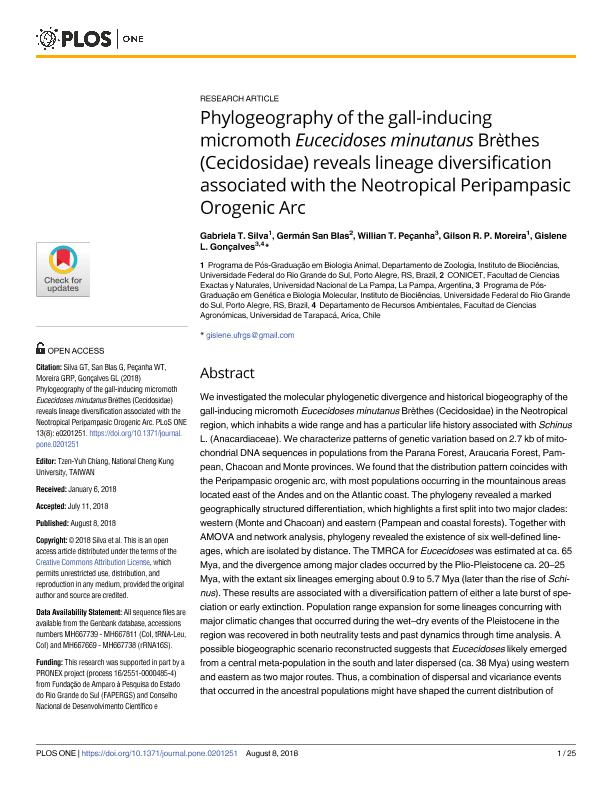Artículo
Phylogeography of the gall-inducing micromoth Eucecidoses minutanus Brèthes (Cecidosidae) reveals lineage diversification associated with the Neotropical Peripampasic Orogenic Arc
Silva, Gabriela T.; San Blas, Diego German ; Peçanha, Willian T.; Moreira, Gilson R. P.; Gonçalves, Gislene L.
; Peçanha, Willian T.; Moreira, Gilson R. P.; Gonçalves, Gislene L.
 ; Peçanha, Willian T.; Moreira, Gilson R. P.; Gonçalves, Gislene L.
; Peçanha, Willian T.; Moreira, Gilson R. P.; Gonçalves, Gislene L.
Fecha de publicación:
08/2018
Editorial:
Public Library of Science
Revista:
Plos One
ISSN:
1932-6203
Idioma:
Inglés
Tipo de recurso:
Artículo publicado
Clasificación temática:
Resumen
We investigated the molecular phylogenetic divergence and historical biogeography of the gall-inducing micromoth Eucecidoses minutanus Brèthes (Cecidosidae) in the Neotropical region, which inhabits a wide range and has a particular life history associated with Schinus L. (Anacardiaceae). We characterize patterns of genetic variation based on 2.7 kb of mitochondrial DNA sequences in populations from the Parana Forest, Araucaria Forest, Pampean, Chacoan and Monte provinces. We found that the distribution pattern coincides with the Peripampasic orogenic arc, with most populations occurring in the mountainous areas located east of the Andes and on the Atlantic coast. The phylogeny revealed a marked geographically structured differentiation, which highlights a first split into two major clades: western (Monte and Chacoan) and eastern (Pampean and coastal forests). Together with AMOVA and network analysis, phylogeny revealed the existence of six well-defined lineages, which are isolated by distance. The TMRCA for Eucecidoses was estimated at ca. 65 Mya, and the divergence among major clades occurred by the Plio-Pleistocene ca. 20±25 Mya, with the extant six lineages emerging about 0.9 to 5.7 Mya (later than the rise of Schinus). These results are associated with a diversification pattern of either a late burst of speciation or early extinction. Population range expansion for some lineages concurring with major climatic changes that occurred during the wet±dry events of the Pleistocene in the region was recovered in both neutrality tests and past dynamics through time analysis. A possible biogeographic scenario reconstructed suggests that Eucecidoses likely emerged from a central meta-population in the south and later dispersed (ca. 38 Mya) using western and eastern as two major routes. Thus, a combination of dispersal and vicariance events that occurred in the ancestral populations might have shaped the current distribution of extant lineages. Speciation driven by host plant shift is potentially involved in the evolutionary history of Eucecidoses.
Palabras clave:
Cecidosidae
Archivos asociados
Licencia
Identificadores
Colecciones
Articulos(CCT - PATAGONIA CONFLUENCIA)
Articulos de CTRO.CIENTIFICO TECNOL.CONICET - PATAGONIA CONFLUENCIA
Articulos de CTRO.CIENTIFICO TECNOL.CONICET - PATAGONIA CONFLUENCIA
Citación
Silva, Gabriela T.; San Blas, Diego German; Peçanha, Willian T.; Moreira, Gilson R. P.; Gonçalves, Gislene L.; Phylogeography of the gall-inducing micromoth Eucecidoses minutanus Brèthes (Cecidosidae) reveals lineage diversification associated with the Neotropical Peripampasic Orogenic Arc; Public Library of Science; Plos One; 13; 8; 8-2018; 1-38
Compartir
Altmétricas



